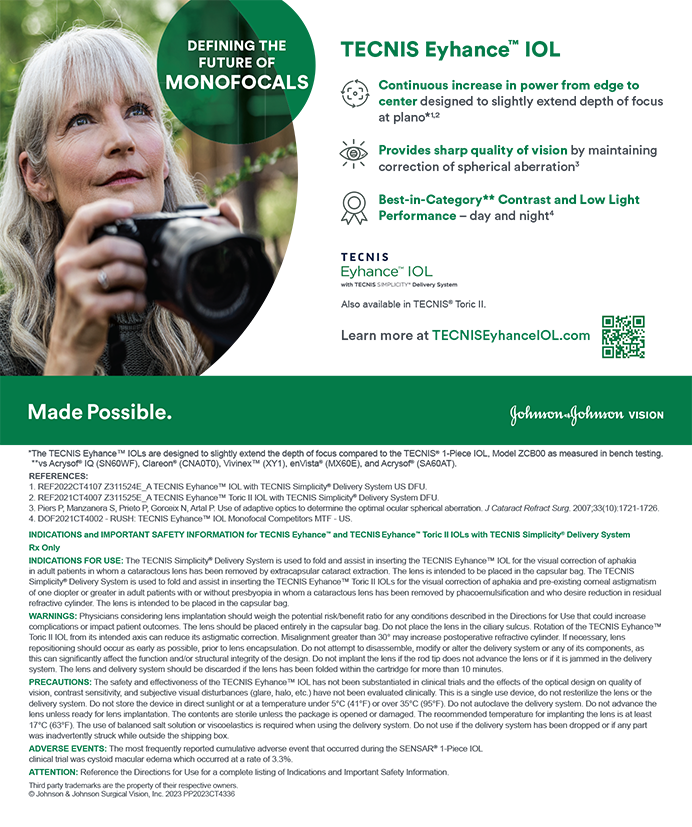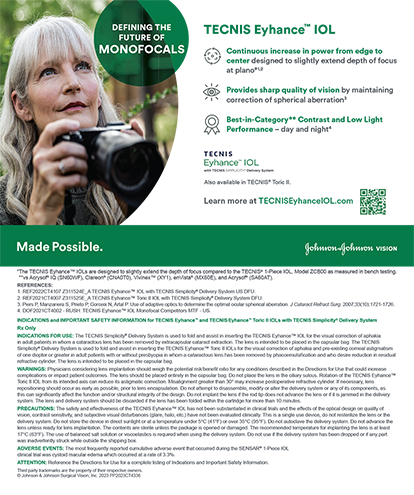If an IOL is already present in the ciliary sulcus, is the Visian ICL (STAAR Surgical Company, Monrovia, CA) a good choice for correcting residual refractive error if the patient is not a candidate for laser vision correction?
SHELDON HERZIG, MD
In certain situations, an ICL may be a good option for eliminating a refractive error after lens replacement surgery. Residual refractive errors are usually small, so the appropriate ICL power may not be available. If an IOL is already in the sulcus, and if laser vision correction is not appropriate, the options for correcting the refractive error are an IOL exchange or a piggyback lens. An ICL would be more compatible as a piggyback lens versus a second IOL implanted in the sulcus.
I had a patient who had a monocular cataract removed 2 years ago and whose refractive error was -10.00 D in that eye after surgery. The fellow eye, which recently needed cataract extraction, was -12.00 D. The patient wanted both eyes to be plano. She was an ideal candidate for an ICL in the pseudophakic eye, but she opted for an IOL exchange because of the phakic lens’ cost.
GREGORY PARKHURST, MD
No room at the inn? Think again. In a pseudophakic eye that has an IOL in the ciliary sulcus and residual refractive error, implanting an ICL has been done and may be a reasonable option to consider. Piggyback acrylic or silicone IOLs are typically more appropriate when the primary IOL has been placed in the capsular bag. The advantage of using the ICL in this setting is that the lens is significantly thinner and more pliable than other piggyback IOLs that take up more room in an already occupied ciliary sulcus. The other advantage of using the collamer material is that it is extremely easy to explant. If problems with pigmentary dispersion or occlusion of the angle were to occur, the lens could be removed quite simply. The circumstances under which this technique might come into play are unusual, at least in the United States, where the available powers of the ICL are limited compared with the toric and hyperopic versions available internationally. In the case of someone with residual myopia of -3.00 D or greater, minimal astigmatism, and a cornea that cannot undergo excimer laser ablation, an ICL might be a reasonable option to offer to the patient who cannot tolerate spectacles or contact lenses.
ROBERT P. RIVERA, MD
Using the ICL to correct residual refractive error in a patient who does not qualify for an excimer laser ablation is an off-label application that has been reported in the United States and abroad. For the patient who has an IOL implanted in the ciliary sulcus after cataract surgery, the ophthalmologist might have concerns about putting another lens in that space. However, the ICL is not just another lens, given its extremely thin profile at the footplates, which creates an extremely soft and pliable interface at the collamer-tissue junction. In the absence of any uveitis-glaucomahyphema– like complications from the primary pseudophakic IOL, the ICL is a reasonable option for correcting residual refractive error. I recommend performing ultrasound biomicroscopy preoperatively to ensure proper sizing of the ICL relative to the sulcus-to-sulcus biometry and to confirm the absence (or reveal the presence) of any iridocapsular adhesions, vitreous, or other synechiae that would make inserting an ICL problematic.
Section Editor John F. Doane, MD, is in private practice with Discover Vision Centers in Kansas City, Missouri, and he is a clinical assistant professor with the Department of Ophthalmology, Kansas University Medical Center in Kansas City, Kansas. Dr. Doane may be reached at (816) 478-1230; jdoane@discovervision.com.
Sheldon Herzig, MD, is the cofounder and medical director of the Herzig Eye Institute in Toronto. He acknowledged no financial interest in the product or company he mentioned. Dr. Herzig may be reached at (416) 929-2020; sherzig@herzig-eye.com.
Gregory Parkhurst, MD, is a cataract and refractive surgeon at McFarland Eye Centers in Little Rock, Arkansas. He acknowledged no financial interest in the product or company he mentioned. Dr. Parkhurst may be reached at gregory.parkhurst@gmail.com.
Robert P. Rivera, MD, is a cataract and refractive surgeon and partner at Barnet Dulaney Perkins Eye Center in Phoenix. He has a financial interest in STAAR Surgical Company, and he serves as a medical advisor to the company. Dr. Rivera may be reached at (602) 955-1000; rpriveramd@aol.com.


